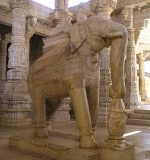| Скачайте и установите необходимые шрифты, чтобы санскрит отображался во всей его красе Прочтите Транслитерация (2) (русский), чтобы полностью понять систему транслитерации |
Протошиваизм - Приложение
Введение: история развития
Author: Andrés Muni
Return to the original article
Appendix of the first article originally in Spanish and brought to you in English by Gabriel Pradīpaka
The following time line consists of four columns:
- The first column enlists the respective years.
- The second one contains relevant facts occurred in India.
- The third column relates to important events happening in Egypt and Middle East.
- The last column enlists crucial facts occurred in the Mediterranean world.
- When the fact comprehends the last three columns, it is implied a world-wide fact that did not occur necessarily in either India, Egypt and Middle East or the Mediterranean world. These facts appears in brown color.
| YEAR BC | INDIA | EGYPT AND MIDDLE EAST | MEDITERRANEAN WORLD |
| 30,000 | Cro-Magnon - Development of complicated funeral rites | ||
| 8,000 | The rupestrian art appears - Man of Combe Chapelle also appears at this time | ||
| 7,000 | Anatolia: Çatal - Höyuk: Stone idols | Cyprus: Mother Goddess | |
| 6,000 |
Homo sapiens is the dominant species in the planet |
||
| 5,600 | Cyprus: Stone idols | ||
| 5,000 | Predynastic Egypt - Cult of the bull | ||
| 4,500 | Anatolia: Copper industry Egypt: Phallic god called Min |
Crete: Beginning of the Minoan period | |
| 4,000 | China: Beginning of the Neolithic period | ||
| 3,800 | Development of the Indian civilizations | Malta: First megalithic monuments | |
| 3,500 | Spreading of the megalithic monuments through Asia and Europe | ||
| Sumer: Arrival of the Sumerian people proceeding from India Prediluvian dynasties Egypt: The egyptians occupy the valley of Nile - First written documents |
Malta: Temple of Skorba Cult of bull and phallus |
||
| 3,200 | Troy foundation | Cyprus: Statues of gods Crete: Copper industry |
|
| 3,000 | Sumer: Historic deluge Egypt: A unified monarchy is consolidated - Beginning of the first dynastic period (first and second dynasties) Malta: Temples of Ġgantija |
||
| 2,800 | Sumer: Postdiluvian dynasties - The first state-cities are founded | Crete: Apogee of the Minoan art | |
| 2,700 | Migration of Aryan tribes | ||
| Protoindian writing | Troy: Sumptuous palaces Egypt: Beginning of the Ancient Empire (third and sixth dynasties) - Great pyramids |
Cyprus: Cult of the bull | |
| 2,600 | Crete: Development of cities | ||
| 2,500 | Apogee of Mohenjo Daro | Syria: Apogee of Ebla (semitic) | England: Stonehenge Malta: Total destruction of the Ġgantija civilization |
| 2,400 | Sumer: Reign of Sargon in Akkad | Malta: Culture of Tarxien | |
| 2,300 | The Aryans set Troy and the Anatolian cities on fire | Cult of bull and phallus | |
| 2,100 | Egypt: End of the Ancient Empire - Beginning of the first middle period (seventh to tenth dynasties), which gives way to the Middle Empire (eleventh and twelfth dynasties) | Crete-Egypt relationship China: Hia dynasty |
|
| 2,000 | Hymns of Ṛgveda | Sumer: End of the Sumerian dynasty | Greece: Arrival of the Achaeans Crete: Palace of Knossos Malta: End of the culture of Tarxien - Total destruction |
| 1,890 | Babylon: Suabum (Su-abu or Sumu-abum), first Semitic king | ||
| 1,800 | The Metal Age begins - Societies are hierarchically structured Big settlements arise - Agriculture is intensified |
||
| Egypt: Commencement of the second middle period (thirteenth to seventeenth dynasties) Abraham of Ur leaves Sumer bound for Canaan Mesopotamia: First Assyrian and Babylonian dynasties |
Greek Aryans settle down in the Balkans |
||
| 1,700 | Destruction of Mohenjo Daro by the Aryans | Syria: Destruction of Ebla by the Hittites (Aryans) Egypt: Invasion of the Asian Hyksos |
Eruption of the volcano Santorini |
| 1,600 |
Departure of the Hebrews bound for Egypt |
||
| 1,500 | Struggle between Aryans and Dravidian for power | Babylon: Kassite domination Egypt: End of the second middle period - New Empire (eighteenth to twentieth dynasties) |
Malta: New settlements Greece: The Achaeans occupy the Peloponnesus - The Mycenaean civilization begins |
| 1,400 | Aryan conquest of Northern India - War of Mahābhārata Atharvaveda: Śaiva doctrines are incorporated to the Aryan religion |
Crete: End of the Minos' reign - Destruction of Knossos by the Achaeans - Minoan doctrines being assimilated to the Mycenaean religion (Aryan) - Mycenaean influence in Crete | |
| 1,300 | Chāndogyopaniṣad | Egypt: Eighteenth dynasty (Tutmosis the Second and the Third, Amenhotep the Fourth) - Temples of Luxor and Deir-el-Bahari - Nineteenth dynasty (Seti the First and Rameses the Second) - Temples of Karnak and Abu-Simbel - Apogee of the Akhenaton's Empire, an attempt to adopt monotheism Babylon: The Assyrians (Semitic) take the city War of Troy The Hebrews are expelled from Egypt |
Cyprus: Mycenaean colonization - Young gods |
| 1,200 | Dorian invasion | ||
| Northern India is turned into Aryan | Iran is turned into Aryan Troy: Final destruction The non-Aryan Phrygians arrives in Anatolia from Thrace |
Writing disappears from Greece The Dorians reach Southern Greece Italy: Aeneas, coming from Troy, settles down in Palatine Cyprus: Destruction on the part of the Dorians |
|
| 1,100 | Babylon: Nabuchodonosor the First (Semitic) Israel: Samuel establishes nobility - Beginning of the Judah reign Egypt: End of the New Empire |
Mycenae: Destruction by the Dorians Crete: Total destruction by the Dorians Italy: The Latin (Aryan) tribes occupy Latium |
|
| 1,000 | The Aryans penetrate into Gujarat | Israel: Reign of David - Reign of Salomon Egypt: Commencement of the Low Empire |
|
| 900 | Brāhmī alphabet is adopted | Anatolia: Reign of Urartu (Aryan) | Greece: Homer - Reappearance of writing Malta: Phoenician influence |
| 800 | Aryan domination in the valley of Ganges | Cyprus: Assyrian and then Egyptian conquests Foundation of Carthage Greece: First olympic games |
|
| 753 | Rome foundation Greece: Hesiod |
||
| 730 | Greek settlers found Syracuse (Sicily) | ||
| 710 | Greece: Unification of the kingdoms of Attic | ||
| 700 | Italy: Beginning of the Etruscan art | ||
| 680 | Greece: Organization of Athens Colonization of Asia Minor up to the Black Sea Byzantium foundation |
||
| 620 | Mesopotamia: Destruction of Nineveh and Assyrian power | ||
| 600 | Transition from the Vedic culture to Hinduism Use of the Kharoṣṭhī alphabet |
Babylon: Chaldean dynasty. Reign of Nabuchodonosor the Second Babylonians and Scythians take Ninive Jerusalem is captured by the Babylonians End of the Judah kingdom Captivity of the Jews in Babylon |
|
| 562 | Birth of Gautama Buddha | ||
| 550 | Destruction of Urartu by the Medes and Scythians Cyrus, Aryan king of Persia Babylon is taken by the Persians Invasion of Egypt Reign of Darius the First |
||
| 500 | The Achaemenid Empire comprehends from India to Greece The Persians annex India Sanskrit grammar by Pāṇini |
Etruscan development in Northern Italy Etruscan apogee Rome is now an important city |
|
| 483 | Death of Buddha | ||
| 480 | The Persians destroy Athens | ||
| 460 | Greece: Age of Pericles (Plato, Herodotus) Athens is the center of the civilized world |
||
| 429 | Death of Pericles | ||
| 396 | Destruction of Veii (Etruscan) by the Romans (Aryan) | ||
| 356 | Alexander of Macedonia is born | ||
| 350 | End of the Etruscan Empire | ||
| 330 | Egypt: End of the Low Empire | ||
| 326 | Expedition of Alexander and subjugation of Gandhara | ||
| 323 | Death of Alexander in Babylon | ||
| 321 | Candragupta (Mauryan dynasty) | ||
| 300 | Megasthenes in the court of Candragupta | ||
| 274 | King Aśoka imposes Buddhism | Italy: End of the Etruscans The Romans take Tarentum |
|
| 218 | Malta: Roman occupation | ||
| 206 | Antiochus' (king of Syria) expedition to India | ||
| 200 | Sanskrit works by Patañjali | ||
| 146 | Ajanta | Carthage and Corinth are destroyed by the Romans | |
| 135 | The Scythians invade Bactria | Greece is subjugated by Rome | |
| 26 | Indian commission before Augustus | ||
Return to the beginning of the article
Этот документ был составлен Габриэлем Pradīpaka, одним из двух основателей этого сайта, духовным гуру, экспертом в санскрите и философии Трика.
Для получения дополнительной информации о санскрите, йоге и философии, или если вы просто хотите оставить комментарий, задать вопрос или нашли ошибку, напишите нам: Это наша электронная почта.
| Вернуться Протошиваизм | Продолжить чтение Лук и чеснок |





























